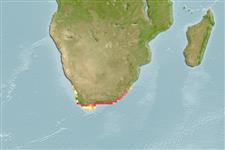Common names from other countries
Elasmobranchii (tubarões e raias) (sharks and rays) >
Carcharhiniformes (Ground sharks) >
Triakidae (Houndsharks) > Triakinae
Etymology: Triakis: tri-, from tres (L.), three; akis (Gr.), point, referring to each tooth consisting of one large central cusp flanked on by both sides by a small cusplet. (See ETYFish); megalopterus: mega-, from megas (Gr.), large; pterus (Gr.), fin, referring to its broad, large fins. (See ETYFish).
More on author: Smith.
Environment: milieu / climate zone / depth range / distribution range
Ecologia
marinhas demersal; intervalo de profundidade 1 - 50 m (Ref. 5578). Subtropical; 30°S - 36°S
Southeast Atlantic: Namibia to Coffee Bay, South Africa.
Length at first maturity / Tamanho / Peso / Idade
Maturity: Lm 145.0, range 140 - 150 cm
Max length : 142 cm TL macho/indeterminado; (Ref. 244); 174.0 cm TL (female); peso máx. Publicado: 20.0 kg (Ref. 5485)
Descrição breve
Chaves de identificação | Morfologia | Morfometria
Espinhos dorsais (total) : 0; Espinhos anais: 0. Blunt snout and a large mouth with small pointed teeth; caudal peduncle short and heavy (Ref. 5578). Grey with numerous black spots which may be sparse or absent in some specimens; new born pups with fewer black spots compared to adults (Ref. 5485); white below (Ref. 5578).
Occurs off sandy beaches, rocky shores and in shallow bays (Ref. 5578). Feeds on crabs, lobsters, bony fish and small sharks (Ref. 5578). Ovoviviparous (Ref. 50449). Forms schools in summer (Ref. 244). Hardy and keeps well in captivity (Ref. 244). Commonly caught by rock and surf sports anglers but not eaten much (Ref. 244). Meat is dried into shark 'biltong' or jerky which commands a relatively high price (Ref. 244). Attains 160 cm, TL (Ref. 36731).
Ovoviviparous, embryos feed solely on yolk (Ref. 50449), with 6 to 12 young in a litter (Ref. 244). 30-32 cm at birth (Ref. 244).
Compagno, L.J.V., 1984. FAO Species Catalogue. Vol. 4. Sharks of the world. An annotated and illustrated catalogue of shark species known to date. Part 2 - Carcharhiniformes. FAO Fish. Synop. 125(4/2):251-655. Rome: FAO. (Ref. 244)
Categoria na Lista Vermelha da IUCN (Ref. 130435)
CITES (Ref. 128078)
Not Evaluated
Ameaça para o homem
Harmless
Utilização humana
Pescarias: pouco comercial; peixe desportivo: sim; Aquário: Aquários públicos
Ferramentas
Relatórios especiais
Descarregue XML
Fontes da internet
Estimates based on models
Preferred temperature (Ref.
115969): 15.8 - 22.4, mean 19.3 (based on 26 cells).
Phylogenetic diversity index (Ref.
82804): PD
50 = 0.5312 [Uniqueness, from 0.5 = low to 2.0 = high].
Bayesian length-weight: a=0.00240 (0.00110 - 0.00521), b=3.14 (2.96 - 3.32), in cm Total Length, based on LWR estimates for this (Sub)family-body shape (Ref.
93245).
Nível Trófico (Ref.
69278): 4.0 ±0.5 se; based on diet studies.
Resiliência (Ref.
120179): Muito baixo, tempo mínimo de duplicação da população maior que 14 anos (Fec=6).
Fishing Vulnerability (Ref.
59153): Very high vulnerability (90 of 100).
